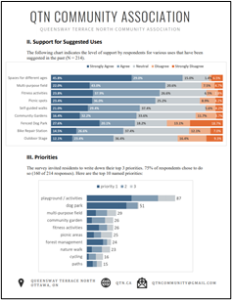QTN residents care deeply about the green spaces and parks in our neighborhood. That came through strongly in the 214 responses to a survey sponsored by the community association. The responses included desired uses, suggestions for improvements, and concerns. These will inform further discussions within QTN and with City parks officials and our City Councillor.
Parks and recreation
Updated – Management of QTN’s Tree Canopy and Forests – Q&A
Your community association and its network of volunteers have compiled this information piece to answer the most common questions on tree management in QTN. Click on any of the questions below to learn more.
The complete definition of what a Professional Forester does is set out in the Professional Foresters Act, 2000: found here: http://www.e-laws.gov.on.ca/html/statutes/english/elaws_statutes_00p18_e.htm
Infected Ash Borer trees deemed to be a safety concern were removed from the two Woods in the winter of 2015 and in the fall of 2020. In the spring 2015, 2,500 saplings from native species were planted to replace the lost of the lost ash trees and increase species diversity. Subsequent monitoring in 2019 resulted in the planting of an additional 500 trees. In the summer of 2021, excess tree trunks left in Elmhurst Woods were removed and some of the mulch from these trunks was spread over the main trails. The planting of saplings is scheduled for that area during the 2022-2023 season as well as some discrete areas in Frank Ryan Woods where tree cover is light.
Unfortunately, City Arborists are generally not allowed to climb dead trees so would be unable to cut the tops of trees out for this purpose. This has limited the number of possibilities for leaving dead trunks to benefit wildlife as they can only do this for dead trees they can reach with a bucket truck and NOT damage other trees while doing so.
Tree compensation requirements are provided in Schedule B of the Tree Protection (By-law No. 2020-340) which came into effect on January 1st, 2021 and found here: https://ottawa.ca/en/living-ottawa/laws-licences-and-permits/laws/laws-z/tree-protection-law-no-2020-340#section-695bd9df-6cab-4f74-88c2-8c03f3a2bb71
City Forestry staff are aware and monitoring the situation with spongy moth. City staff are in contact with experts and stakeholders across the province.
Defoliation does not typically harm the tree or cause mortality. In many cases trees can produce additional leaves later in a growing season to compensate for losses.
There are individual control options for residents to consider in order to reduce the impact of the spongy moth on their property – primarily physical removal of caterpillars and egg masses.
Questions about insects on City trees or specific questions about insect control can be directed to 311 (613-580-2400 or 311@Ottawa.ca).
For more information about the gypsy moth visit:
Ecology Ottawa organises tree giveaways annually during the planting season (from spring the fall). Their staff of volunteers can advise you on the best species to plant at your location. You can visit any of their pop-up tree giveaway location and take home saplings for planting on your private property. QTN has been the host of such giveaways in the summer of 2021 and spring 2022 and are planning to make these an annual event. The Ecology Ottawa tree giveaway calendar is here: https://www.ecologyottawa.ca/tree_giveaway_events
Neighbourhoods with trees and natural areas promote physical activity which benefits health and well being. Spending time around trees and in urban rural areas helps to reduce stress, anger, fatigue, sadness and anxiety and it also helps to increase energy. Trees moderate temperature and can help your save on your air conditioning costs. They provide shade to help us through the heat waves and provide natural protection against UV rays. Trees are life! They produce oxygen, clean our air and are host to a variety of ecological species.
There are steps that can be taken to minimize the risk that trees and branches fall during extreme weather events. To name a few, arborists suggest having your trees trimmed regularly, planning for and maintaining sufficient rooting space, and avoiding placing mulch at the base of the tree.
One invasive species has been spotted along the main trail of Frank Ryan wood: the garlic mustard. This garlic mustard is edible and was introduced as a food source. It is deemed invasive because where present, it will tend to take over areas and impact biodiversity. To prevent spreading of non native plants, we ask you to not plant along the forest edges and to not dispose of yard or garden plants in the forest. You can learn more about invasive plants and alternative plants for your garden from the Grow-Me-Instead booklet: https://www.ontarioinvasiveplants.ca/wp-content/uploads/2016/07/GMI-Booklet_FINAL-FOR-WEB_May132016.pdf
Upgrades to Frank Ryan Playground (2024)

Good news! Upgrading the playground at Frank Ryan Park is on the list of projects for which the City received federal and prov funding. This project is scheduled for 2024. What exactly will be funded is not yet known. There will be consultation with the community before plans are finalized.
- Funding announcement from the Federal Government (Canada.ca)
- Funding announcement by Mayor Jim Watson (twitter)
Meanwhile QTNca is focusing on other issues related to local use of the parks in our area. For example, we continue to raise issues of access for parents with children in strollers and persons using wheelchairs and walkers. Expanding the community gardens as demand increases in addition to other community activities such as park clean-ups and spreading wood chips to improve the paths in Elmhurst Park. If you have not done so already, please share your thoughts with us on local priorities for QTN park spaces.

